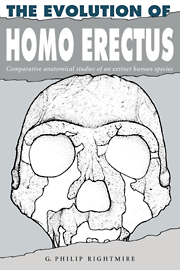Book contents
- Frontmatter
- Contents
- Preface
- 1 Introduction
- 2 Homo erectus in the Far East
- 3 Homo erectus at Olduvai Gorge
- 4 Discoveries from the Turkana basin and other localities in sub-Saharan Africa
- 5 Northwest Africa
- 6 Comparisons of African hominids with Asian Homo erectus
- 7 Homo erectus as a paleospecies
- 8 The transition to more modern forms
- 9 Summary and prospects for further research
- References
- Author index
- Subject index
2 - Homo erectus in the Far East
Published online by Cambridge University Press: 14 October 2009
- Frontmatter
- Contents
- Preface
- 1 Introduction
- 2 Homo erectus in the Far East
- 3 Homo erectus at Olduvai Gorge
- 4 Discoveries from the Turkana basin and other localities in sub-Saharan Africa
- 5 Northwest Africa
- 6 Comparisons of African hominids with Asian Homo erectus
- 7 Homo erectus as a paleospecies
- 8 The transition to more modern forms
- 9 Summary and prospects for further research
- References
- Author index
- Subject index
Summary
Much information about the evolution of earlier humans has come to light in Asia. A number of important Pleistocene sites are located in China and in Indonesia, and it was of course in Java that the first fossils of Homo erectus were discovered by Eugene Dubois late in the last century. Dubois, a young Dutch physician, went to Indonesia to find the missing link, and he was tremendously lucky. His first specimen, a mandibular fragment, turned up at Kedung Brubus in 1890, and the famous Trinil skullcap was excavated from the banks of the Solo River in central Java in 1891. Dubois' assistants continued to dig at Trinil for another decade, and large quantities of mammal bones were shipped back to Holland. Only a few more hominids were found, and some of the postcranial remains that did appear managed to escape notice for more than 30 years after they were returned to the museum in Leiden.
Later, in the 1920s, more fossils were recovered far to the north, from limestone cave deposits near Beijing in China. This site at Zhoukoudian proved to be immensely rich, and quite a number of well preserved skulls and other bones were eventually excavated from different levels in the cave. Although nearly all of this Chinese Homo erectus material was lost during World War II, descriptions of the crania, jaws, teeth and limb bones are on record (Weidenreich, 1936, 1937, 1941, 1943).
- Type
- Chapter
- Information
- The Evolution of Homo ErectusComparative Anatomical Studies of an Extinct Human Species, pp. 10 - 56Publisher: Cambridge University PressPrint publication year: 1990



